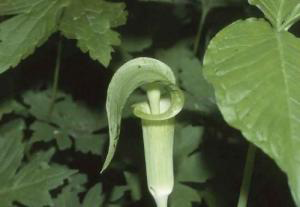Arisaema triphyllum produces crystals of calcium oxalate that are needle-like and are found in all plant tissues; eating most parts of this plant can cause severe pain, if improperly prepared. It has been used medicinally and as a starch for clothes.
Photo Credit: © Robert H. Mohlenbrock, USDA-NRCS PLANTS Database/USDA NRCS. 1995. Northeast wetland flora: Field office guide to plant species. Northeast National Technical Center, Chester.
Arisaema triphyllum
Common Name: jack in the pulpit
Plant Functional Group: Forb
Class > Order > Family: Magnoliopsida > Alismatales > Araceae
What does the species look like?
Jack in the pulpit is an erect, perennial, herbaceous plant that grows 12 to 36 inches tall. Each mature plant produces a single "flower" (inflorescence) that contains very tiny male or female flowers, or occasionally separate male and female flowers on the same plant. Flowers appear when the plant matures at about 3 years of age and are pollinated by insects, generally fungus gnats and thrips.
Jack in the pulpit grows on fertile soils, in moist woodland and forest sites, bottomlands, swamps and bogs on sites with partial sun to shade.
Where is the species found?
States & Provinces
AL, AR, CT, DC, DE, FL, GA, IA, IL, IN, KS, KY, LA, MA, MB, MD, ME, MI, MN, MO, MS, NB, NC, ND, NE, NH, NJ, NS, NY, OH, OK, ON, PA, PE, QC, RI, SC, SD, TN, TX, VA, VT, WI, WV
Special Considerations for Observing
If drought seems to be the cause of leaf senescence for a plant, please make a comment about it for that observation.
Note that some individuals may not produce fruit every year.
Which phenophases should I observe?
Do you see...?
Leaves
Initial growth More...
Leaves More...
Flowers
Flowers or flower buds Arisaema triphyllum , watch for the presence of the brown-striped pulpit (spathe), which contains and hides the flowers. Please do not tear open the pulpit to look for the individual flowers.More...
How many flowers and flower buds are present? For species in which individual flowers are clustered in flower heads, spikes or catkins (inflorescences), simply estimate the number of flower heads, spikes or catkins and not the number of individual flowers.
Less than 3 3 to 10 11 to 100 101 to 1,000 More than 1,000
Fruits
Fruits Arisaema triphyllum , the fruit is a berry that changes from green to orange or bright red.More...
How many fruits are present?
Less than 3 3 to 10 11 to 100 101 to 1,000 More than 1,000
Ripe fruits Arisaema triphyllum , a fruit is considered ripe when it has turned orange or bright red.More...
What percentage of all fruits (unripe plus ripe) on the plant are ripe?
Less than 5% 5-24% 25-49% 50-74% 75-94% 95% or more
Recent fruit or seed drop More...
How many mature fruits have dropped seeds or have completely dropped or been removed from the plant since your last visit?
Less than 3 3 to 10 11 to 100 101 to 1,000 More than 1,000
What do these phenophases look like?
There is currently no photoguide available for this species. If you'd like help us create one, use the guidance document and species template provided here . Then send it via email to education@usanpn.org when it is complete.
